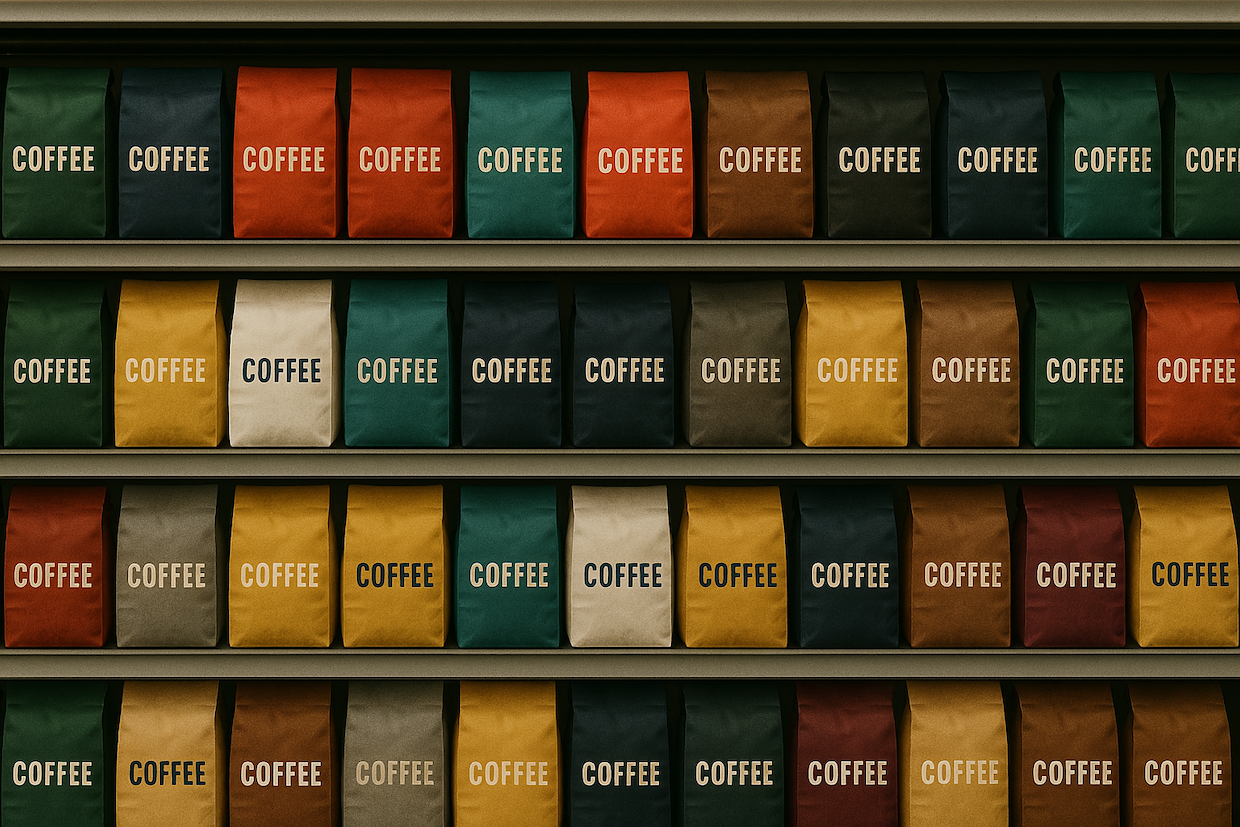
Researchers found that color of coffee bags affects expectations of flavor, as well as certain concepts like “organic.” Image by Daily Coffee News.
A new study explores how the color of coffee packaging exerts a powerful influence on consumer expectations of specialty coffee.
Not only does bag color affect expectations of sensory attributes such as flavors, tastes and aromas, it also creates associations among consumers with external attributes, such as organic certification or modernity, according to the study.
Led by renowned neuroscientist and The Coffee Sensorium Founder Fabiana Carvalho, the research findings suggest practical applications for specialty coffee market actors — including producers, importers and roasters — seeking to tap into the minds of coffee buyers.
“These findings demonstrate the potential of using packaging colors strategically to align sensory and conceptual expectations with product characteristics,” the study states. “The insights are particularly relevant for the specialty coffee sector aiming to differentiate their offerings and appeal to specific consumer segments through optimized packaging design, contributing both to producers in coffee-producing countries by making their products more attractive to consumers, and to importers of specialty coffee in a highly competitive market that seeks differentiation.”
Published in the Elsevier journal Food Research International, the study was supported by the Coffee Science Foundation, a sibling nonprofit to the Specialty Coffee Association trade group, and underwritten by coffee packaging company Savor Brands. Carvalho and associates did not disclose any conflicts outside of publishing costs and paid travel.
Methodology
The study involved online surveys with 238 United States adults who identified as specialty coffee drinkers. Participants were presented with realistic digital images of coffee bags in eight different colors, each with two different levels of saturation, or hues.
For each bag, including black and white samples, participants were asked to indicate expectations of how much they would like the coffee overall, as well as expectations regarding aroma, flavor intensity, sweetness, acidity and bitterness. They were also asked to check-all-that-apply for specific flavor types, such as berry or cocoa.
Participants were also asked whether certain colors made them think of functional or “affective” concepts — such as “organic,” “decaffeinated,” “modern” or “sophisticated.”
Findings
One of the study’s clearest takeaways is that certain colors elicit specific taste and flavor expectations. Pink consistently signaled sweetness and the possibility of berry or floral flavor notes. Yellow suggested higher acidity and citrus flavors. Brown and black both implied bitterness, dark roast and cocoa notes.
Meanwhile, colors like green conveyed a sense of being “organic” or environmentally friendly, and pink also evoked the notion of modernity and higher anticipated liking.
Saturation — how intense or pale the color appeared — appears to play a major role in consumer expectations, as well, according to the authors.
High saturation increased expectations of more intense flavor, stronger bitterness, higher roast levels, and a fuller body. At the same time, participants tended to expect that these darker, more vivid colors would be less likable overall, potentially because specialty coffee drinkers frequently associate extreme roast levels and dominant bitterness with lower quality.
Packages with lower color saturation — the lighter, paler hues — were deemed more likely to contain coffee with balanced sweetness and floral or fruity qualities.
Interestingly, participants rated white, pink, and pale blue packaging as especially appealing. Younger respondents tended to prefer coffee flavors described as fruity or floral, and they gravitated toward more colorful or lighter-hued packaging, like pink or yellow. Older participants, on the other hand, were more receptive to coffee in brown packaging.
Beyond taste, the color also influenced conceptual meanings. Black and brown packs were largely associated with the term “commercial.” Green was linked strongly to “organic.” Pink and yellow, regardless of intensity, were deemed “modern,” and pale blue signaled “sophisticated.”
The authors note that these associations may arise from both the learned link between colors and tastes — such as pink with sweetness in fruit-flavored products — and from broader cultural cues, like using green to denote sustainability or black to connote mainstream coffee offerings.
Marketing Coffees
Notably, the study suggests how specialty coffees “should” be marketed.
“As a practical implication, specialty coffees should be marketed using label designs featuring colors that generate (1) flavor expectations aligned with the actual flavor profile of the coffee (i.e., intrinsic aroma/flavor notes) and (2) conceptual expectations consistent with the product type,” the authors wrote. “Color can, therefore, help consumers navigate their choices by addressing both the affective and functional aspects of the coffee, as well as its intrinsic attributes.”
All this talk of “intrinsic” and external, or “extrinsic” attributes seems to dovetail nicely with the SCA’s new Coffee Value Assessment system and protocols (CVA), which the trade group has been promoting as a replacement of its legacy cupping protocols and forms for professional coffee cuppers.
Comments? Questions? News to share? Contact DCN’s editors here. For all the latest coffee industry news, subscribe to the DCN newsletter.
Related Posts
Nick Brown
Nick Brown is the editor of Daily Coffee News by Roast Magazine.







Comment